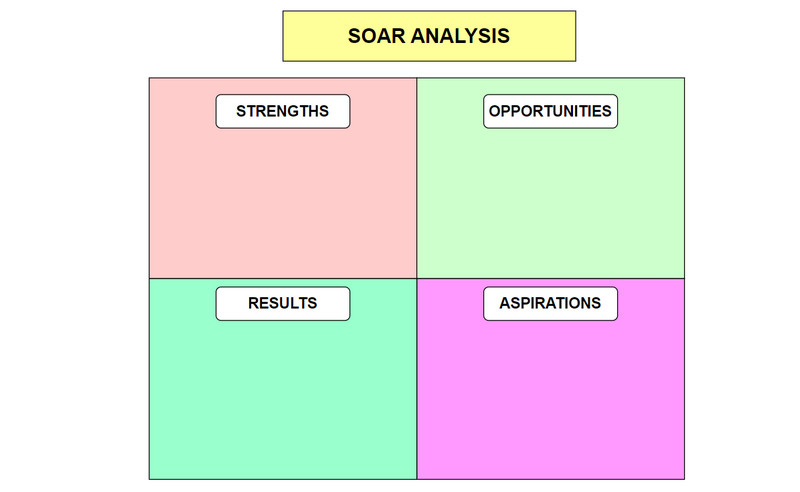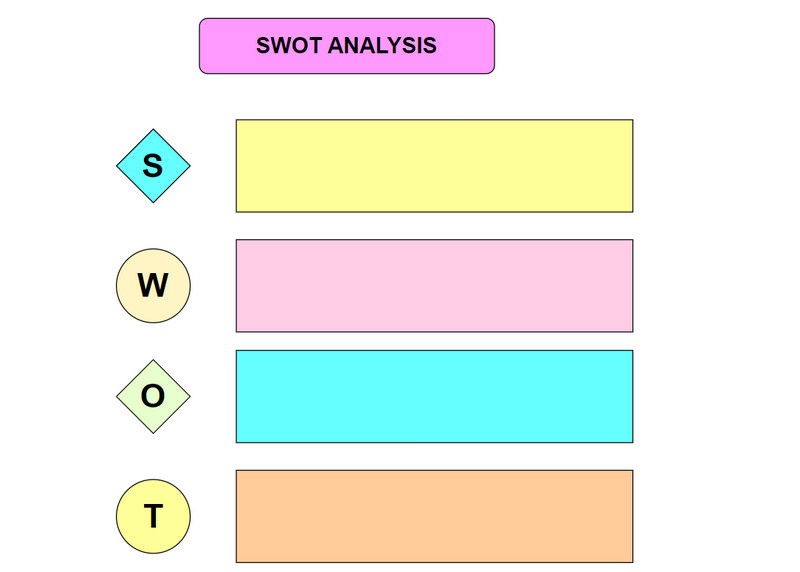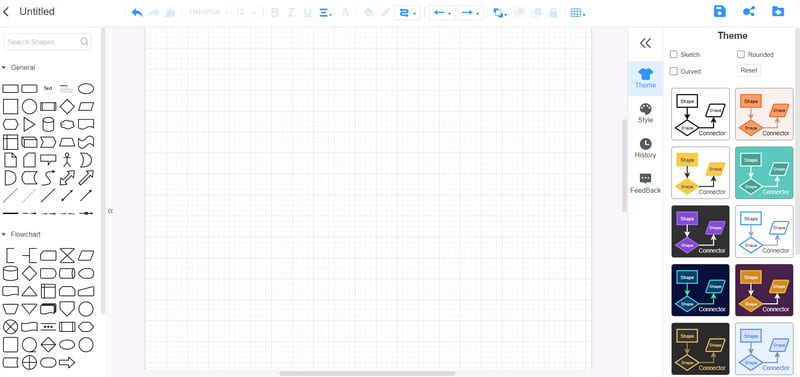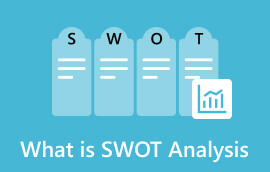Define and See Differences Between SOAR and SWOT Analysis
Are you confused about SWOT and SOAR analysis? If so, we’re here to guide you. In this post, we will tackle SWOT and SOAR analysis. You will see their differences and which one is better. After that, if you want to create the analysis, we are here to help you. We will provide the most effective tool you can use online for making the diagram. So, to learn everything about SOAR vs. SWOT analysis, check the article.

- Part 1. What is SOAR Analysis
- Part 2. Introduction to SWOT Analysis
- Part 3. Differences Between SOAR and SWOT
- Part 4. Which One is Better: SWOT vs. SOAR
- Part 5. Best Tool to Do SOAR and SWOT Analysis
- Part 6. FAQs about SOAR vs. SWOT
Part 1. What is SOAR Analysis
The SOAR analysis diagram is an amazing strategic/planning tool that can offer clear and meaningful data about the business. The SOAR stands for strengths, opportunities, aspirations, and results. Also, the analysis may help a business to discover its strengths and potential. This way, it can create a bright future while improving the business. SOAR analysis focuses more on the positive side. Unlike other analyses, it shows the negative side of the business by indicating its weaknesses. To give you more ideas about SOAR analysis, we’ll give you detailed information on each. Also, you can view the sample SOAR analysis below to visualize its appearance.

Get the example of the SOAR analysis.
Strengths
If we talk about strength, it is about what the organization or business does well. It may relate to important capabilities, assets, achievements, and resources. It also relates to competitive advantage and unique selling propositions. If you want to brainstorm with your team about the possible strength of the business, you can use the simple question guide below.
◆ What does our business do well?
◆ What are our advantages to other businesses?
◆ What is our business’ greatest accomplishment?
◆ What is the organization’s Unique Selling Proposition?
Opportunities
In the SOAR analysis, writing the opportunities is essential. If you can determine potential and available opportunities in the market, you can identify which method can help the current condition of the wider market share. The strategy in the analysis focuses on the external advantages the company can achieve. To give you more ideas about listing opportunities for company development, use the questions below.
◆ What are the current trends that a company can capitalize on?
◆ Can we build a good partnership with other businesses?
◆ Is it possible for the company to fill a market gap?
◆ How can we provide the needs and wants of the customers?
Aspirations
When discussing aspirations, it is about the vision that builds on strengths. It can be inspiring, meaningful, and challenging. The organization must be passionate about creating a positive difference. Also, you will put the company’s ambition in the aspiration section. Something that a company wants to achieve shortly. With that in mind, use the question below when brainstorming with your organization.
◆ What inspires our business?
◆ What is our main goal?
◆ What does our company care about?
◆ What is the vision of the company?
Result
After you qualify the aspirations, it is time to quantify them with results. Results update businesses on whether they accomplished success by helping them clarify their aspirations and visions into good outcomes. It would be helpful to look for the guide questions below for a better understanding.
◆ How do we turn our future aspirations into measurable information?
◆ How does the company define success?
◆ How does the company track its performance?
Part 2. Introduction to SWOT Analysis
SWOT analysis is another strategic plan that may help the company, businesses, or organization to improve. SWOT means strengths, weaknesses, opportunities, and threats. These factors may affect the company's future performance. With the help of the analysis, the company can create an excellent and effective strategy that may help them take advantage of other businesses. You can view the SWOT analysis example below to understand the diagram. After that, we will explain each factor to clarify everything in the analysis.

Get the example of SWOT analysis.
Strengths
In the strength section, it tells about the achievement of the company. It also includes good financial performance, brand, reputation, numbers of consumers, and more. Inserting the company's strengths in the diagram will help the member view its capabilities. If you want to create a SWOT analysis and want to start with inserting the strengths, see the guide questions below.
◆ What do we do best?
◆ How is the business unique from other competitors?
◆ What does the consumer like about the business?
◆ Which categories beat out the competitors?
Weaknesses
In this section, the company must also insert its weaknesses. It is necessary to create an effective solution to a particular weakness. This way, the company can overcome its weakness and turn it positive.
◆ What initiatives are underperforming?
◆ What needs to develop and improve?
◆ What resources need to develop for the performance?
◆ How to rank the company against other businesses or competitors?
Opportunities
Another important thing you need to insert in the SWOT analysis is opportunities. These are the possible assets or ways for the improvement of the company. It includes business expansion, partnerships, marketing strategies, and more. It can also be the best reason for the company’s success.
◆ What resources to use for overcoming weaknesses?
◆ What can the competitors offer?
◆ How can we collaborate?
◆ What is the best marketing strategy?
Threats
In SWOT analysis, a threat can give harm to the business. It is incomparable to the company’s weaknesses. Some of the threats are uncontrollable and unpredictable. It includes pandemics, laws, economic downturns, competitors, and more. Inserting potential threats into the analysis can help the company know what may happen.
◆ Who will be the competitors?
◆ What are the possible changes in laws?
◆ What kind of economic downturns the company may face?
Part 3. Differences Between SWOT and SOAR
See the explanation below if you want to know more about the differences between SOAR and SWOT analysis.
◆ The SWOT analysis uses a tactical action plan, while the SOAR analysis involves a visionary-based action plan.
◆ The SOAR analysis focuses on possibilities. The SWOT analysis focuses on limitations.
◆ If you want to create an analysis with a collaborative mindset, use SOAR analysis. If you are creating a diagram with a competitive mindset, use the SWOT analysis.
◆ The SOAR analysis is perfect for new start businesses, while the SWOT analysis suits experienced businesses.
◆ SOAR analysis involves strategic involvement, while SWOT analysis involves the strategic involvement of weaknesses.
Part 4. Which One is Better: SWOT vs. SOAR
The SOAR and SWOT analysis is perfect for businesses that want to determine various factors. But, these analyses are better in their fields. If the business is new and has no experience yet in the market, then SOAR analysis is a better framework. It allows you to insert strengths, opportunities, aspirations, and possible results. On the other hand, if the business already has much experience in the market, it is better to use the SWOT analysis. This way, the company will know the accomplishments of the business. It also includes determining the weaknesses and threats hindering the company’s development. So, as you can see, both analyses are good for the business. It only depends on the business and the main goal.
Part 5. Best Tool to Do SOAR and SWOT Analysis
If you want the best tool for making the SOAR and SWOT analysis, try MindOnMap. It is an online tool that is accessible to all web platforms. With the help of MindOnMap, you can make an excellent SOAR and SWOT analysis. The tool can offer various functions you need for the diagram-making procedure. It has various elements like shapes, fonts, lines, arrows, tables, etc. Also, if you prefer creating a colorful analysis, you can do so. When using MindOnMap, you can operate Fill and Font colors. With these functions, you can add color to your fonts and shapes.
Plus, making the analysis is simple since the tool’s interface is not confusing compared to another diagram creator. Aside from that, since creating the SOAR and SWOT analysis needs collaboration, using MindOnMap is perfect. The tool has a collaborative feature that allows you to work with your team by sending the link to the diagram. This way, you can still create the analysis even if you are not together.
Secure Download
Secure Download

Further Reading
Part 6. FAQs about SOAR vs. SWOT
What are the similarities between SWOT and SOAR?
If you see the diagram, the similarity of the analysis is that they both need to determine the strengths and opportunities for the business. Also, another similarity they have is they can be helpful for the company’s development.
What is the main purpose of SOAR?
The main purpose of the SOAR analysis is to help the company determine its strengths, opportunities, aspirations, and results. The company will better understand how to improve the business with these factors.
What replaced SWOT analysis?
Various analyses can be used as an alternative to SWOT analysis. It includes the SOAR, PESTLE, NOISE, and Five Forces analysis. These diagrams can be helpful for the development of the business.
Conclusion
You discovered SOAR vs. SWOT in this article. With that, you will know what to use in the business. Also, you learned about their differences, especially the factors that can help the company to grow. Upon reading, you also discovered the best diagram creator, MindOnMap. So, it is helpful to know this tool, especially when the time comes that you need a reliable SWOT maker.











